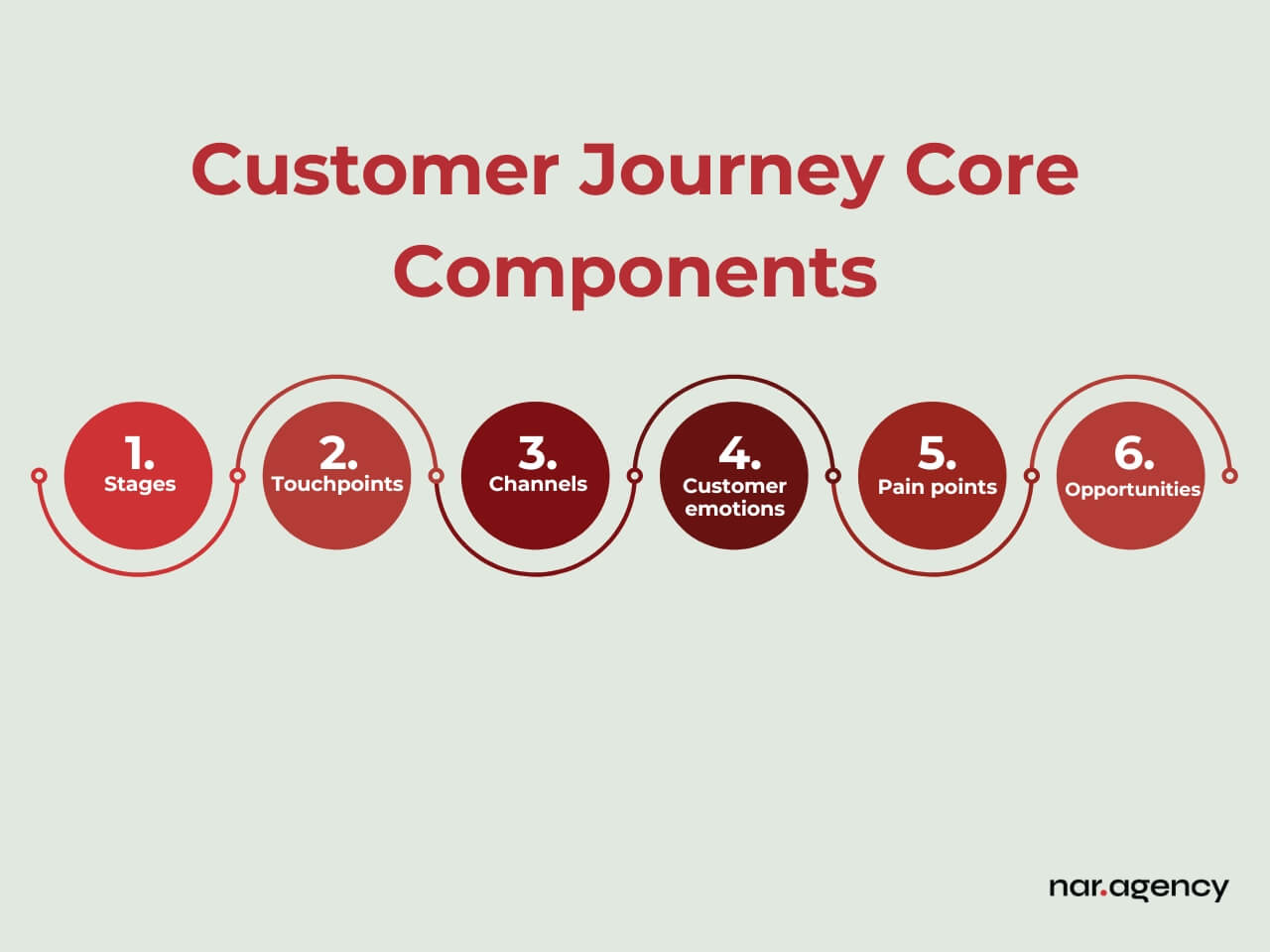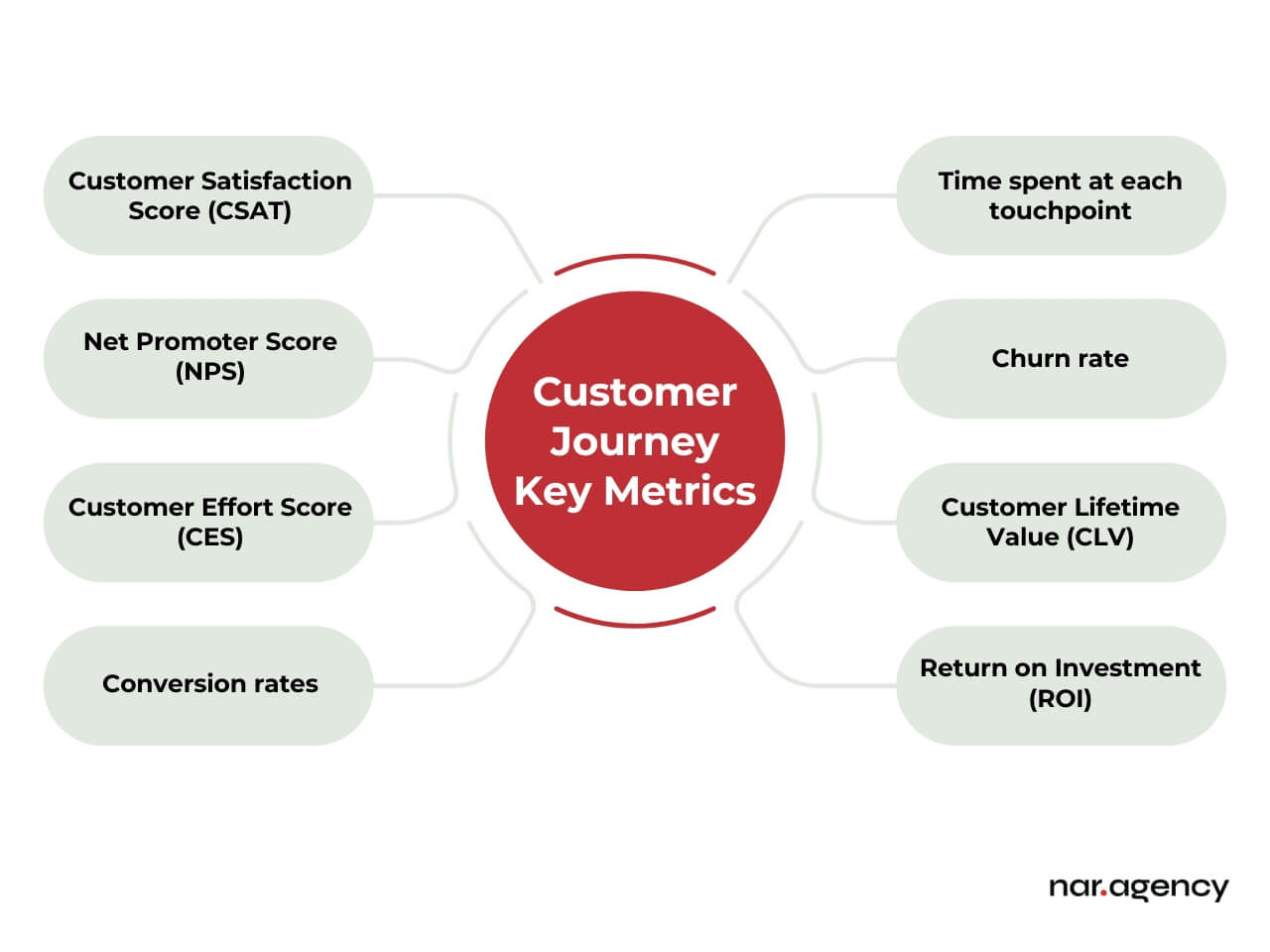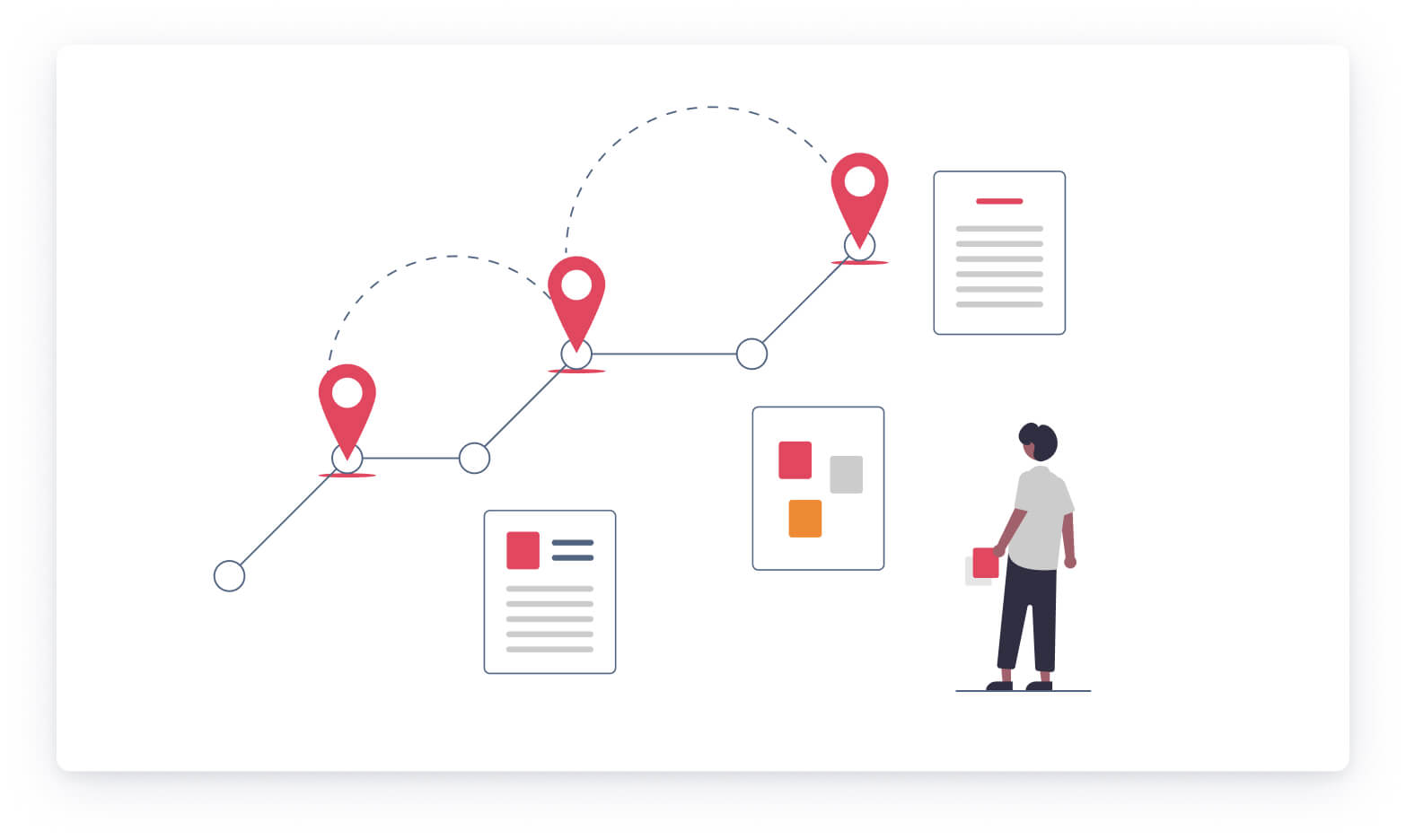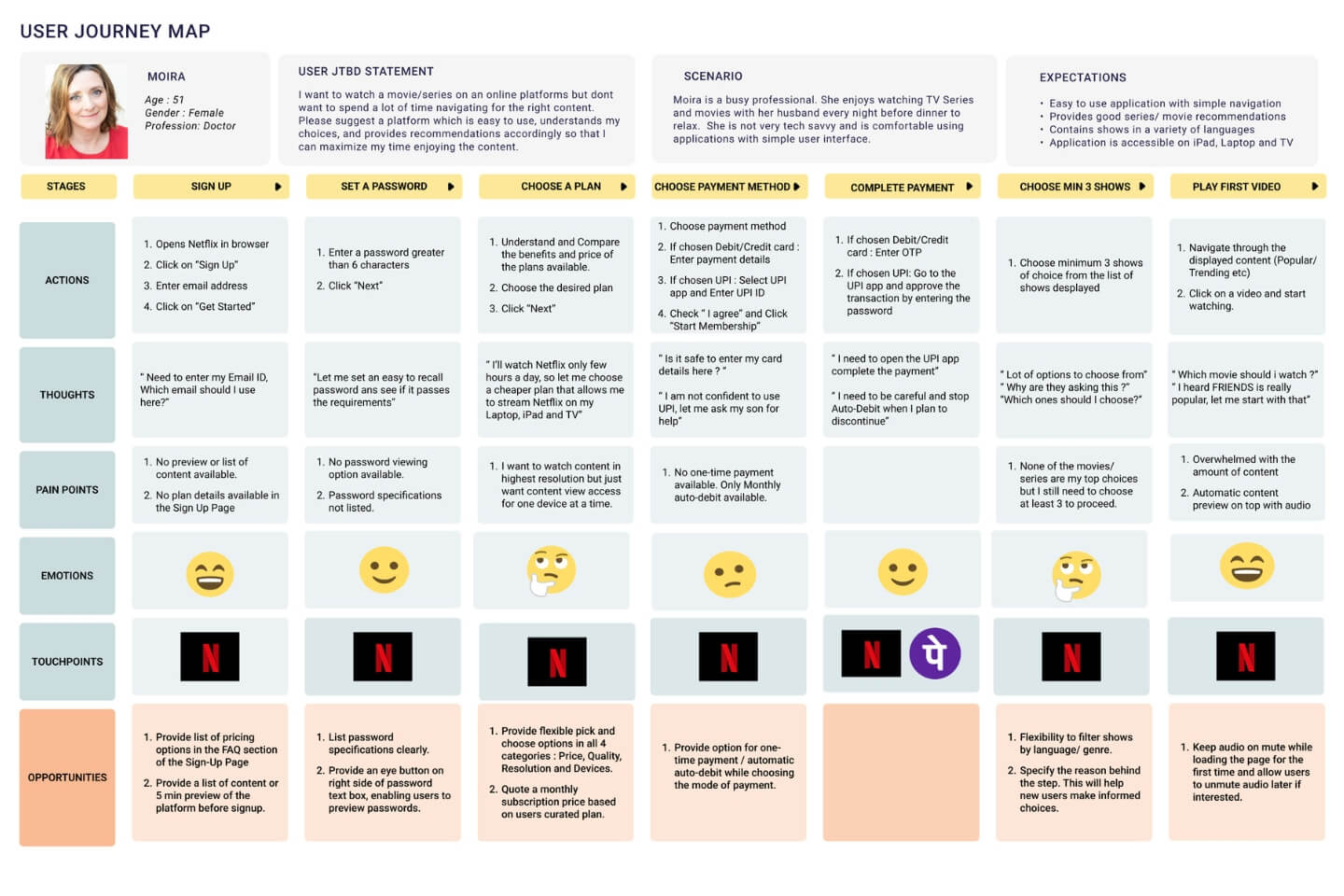Table of Contents
Understanding your customer’s journey is more crucial than ever. But what exactly is a customer journey, and why should businesses care?
A customer journey encompasses all the interactions a customer has with your brand, from their first awareness of your product or service to becoming a loyal advocate. It’s the complete experience a customer goes through when engaging with your company, including every touchpoint and channel along the way.
The importance of mapping and optimizing the customer journey in modern business strategy cannot be overstated. According to a study by McKinsey, companies that prioritize customer journey management see a 10-15% increase in revenue and a 20% reduction in cost to serve. By understanding and improving your customer’s journey, you can:
Enhance customer satisfaction and loyalty
Identify pain points and opportunities for improvement
Increase conversions and sales
Reduce customer churn
Gain a competitive edge in your market
In this comprehensive guide, we’ll dive deep into the world of customer journey. We’ll explore what it is, why it matters, and how you can leverage it to drive growth and success for your business. From creating your first customer journey map to advanced analytics and optimization techniques, this article will equip you with the knowledge and tools you need to transform your customer experience.
Let’s embark on this journey together and unlock the power of customer-centric strategies for your business.
Understanding the Customer Journey

Key Components of a Customer Journey
To effectively map and optimize your customer’s journey, it’s essential to understand its core components:
Stages: The distinct phases a customer goes through in their interaction with your brand.
Touchpoints: Specific interactions between the customer and your company.
Channels: The various platforms or mediums through which these interactions occur.
Customer emotions: The feelings and attitudes customers experience throughout their journey.
Pain points: Obstacles or frustrations customers encounter along the way.
Opportunities: Potential areas for improvement or innovation in the customer experience.
Stages of the Customer Journey
While every business may have unique nuances in their customer journey, most follow a general five-stage model:
Awareness: The customer becomes aware of a need or problem and discovers your brand as a potential solution.
Consideration: The customer researches and compares options, including your offering.
Decision: The customer chooses to purchase your product or service.
Retention: The customer uses your product or service and may seek support or additional features.
Advocacy: Satisfied customers become brand advocates, recommending your business to others.
Understanding these stages helps you tailor your marketing and customer service efforts to meet customers where they are in their journey.
Understanding these stages helps you tailor your marketing and customer service efforts to meet customers where they are in their journey. For a deeper dive into how these stages align with the marketing funnel and strategies to capture and convert leads at each stage, check out our comprehensive guide on the 5 stages of the marketing funnel.
Touchpoints and Their Significance
Touchpoints are the building blocks of the customer journey. They include:
Website visits
Social media interactions
Email communications
Phone calls or live chat sessions
In-store experiences
Product usage
Customer support interactions
Each touchpoint presents an opportunity to impress or disappoint your customer. By mapping these touchpoints, you can identify which ones are most critical to customer satisfaction and focus your efforts on optimizing them.
Salesforce example
A study by Salesforce found that 76% of customers expect consistent interactions across departments. This highlights the importance of creating a seamless experience across all touchpoints.
In the next section, we’ll explore how to bring all these elements together through customer journey mapping, a powerful tool for visualizing and improving the customer experience.
The Power of Customer Journey Mapping
What is Customer Journey Mapping?
Customer journey mapping is the process of visually representing a customer’s experience with your brand from start to finish. It’s a strategic approach that allows businesses to step into their customers’ shoes and gain a holistic view of the entire customer experience.
A customer journey map typically includes:
Customer actions and decisions
Emotions and motivations
Touchpoints and channels
Pain points and moments of delight
Opportunities for improvement
Benefits of Creating a Customer Journey Map
Implementing customer journey mapping can yield significant benefits for your business:
Enhanced customer understanding: Gain deep insights into customer needs, preferences, and behaviors.
Improved customer experience: Identify and address pain points to create a smoother, more satisfying journey.
Increased customer retention: By addressing issues proactively, you can reduce churn and build loyalty.
Better resource allocation: Focus your efforts and resources on the most impactful touchpoints.
Cross-functional alignment: Unite different departments around a common understanding of the customer experience.
Personalization opportunities: Identify key moments to deliver personalized experiences that resonate with customers.
According to a study by Aberdeen Group, companies with strong customer journey management programs retain 56% more customers than those without.
Types of Customer Journey Maps
There are several types of customer journey maps, each serving a different purpose:
Current State Map: Visualizes the existing customer journey, highlighting pain points and areas for improvement.
Future State Map: Depicts an ideal customer journey, serving as a goal for your team to work towards.
Day-in-the-Life Map: Provides a broader view of the customer’s daily activities and how your product or service fits into their life.
Service Blueprint: Includes behind-the-scenes processes that support the customer journey, useful for identifying internal improvements.
Choosing the right type of map depends on your specific goals and the insights you’re seeking to gain.
How to Create an Effective Customer Journey Map
Creating a customer journey map is a crucial step in understanding and optimizing your customers’ experiences. This powerful tool can reveal insights that drive meaningful improvements in your business. Let’s dive into the process of creating an effective customer journey map.
Step-by-Step Guide
Define your objectives
Start by clearly outlining what you want to achieve with your customer journey map. Are you looking to improve customer retention, increase conversions, or enhance overall customer satisfaction. Having clear goals will guide your mapping process.Create ideal customer profile
Develop detailed profiles of your target customers. Include demographics, behaviors, goals, and pain points. This ensures your map accurately represents the experiences of your actual customers.Identify touchpoints
List all the ways customers interact with your brand across different channels and stages. This includes both online (website, social media, email) and offline (in-store, phone support) touchpoints.Gather customer data
Collect insights from various sources such as:Customer surveys and interviews
Website and app analytics
Social media interactions
Customer service logs
Sales data
Map the current journey
Visualize the existing customer journey, including:Customer actions and decisions
Emotions at each stage
Pain points and moments of delight
Touchpoints and channels used
Analyze the map
Identify areas of friction, opportunities for improvement, and gaps in the customer experience. Look for patterns and trends that emerge from your data.Create an ideal future state map
Design an optimized journey that addresses pain points and enhances positive experiences. This becomes your roadmap for improvement.Implement changes
Develop action plans to bridge the gap between the current and ideal customer journeys. Prioritize changes based on potential impact and feasibility.Monitor and iterate
Continuously gather feedback and refine your map as customer behaviors and preferences evolve. Remember, a customer journey map is a living document that should be updated regularly.
Tools and Templates for Customer Journey Mapping
Several tools can help streamline your customer journey mapping process:
Miro: A collaborative online whiteboard with pre-built customer journey map templates
UXPressia: Specialized customer journey mapping software with customizable templates.
Lucidchart: Diagramming tool with drag-and-drop functionality for creating visual journey maps.
Microsoft Excel or Google Sheets: For those who prefer spreadsheet-based mapping.
Best Practices and Common Pitfalls to Avoid
To ensure your customer journey mapping efforts are successful, follow these best practices:
Involve cross-functional teams to gain diverse perspectives
Use real customer data rather than assumptions
Keep your map dynamic and update it regularly
Focus on emotions as well as actions
Prioritize key touchpoints for immediate improvement
Avoid these common pitfalls:
Creating a map without clear objectives
Overlooking the emotional aspect of the customer journey
Focusing solely on digital touchpoints and ignoring offline interactions
Failing to act on the insights gained from the map
Neglecting to update the map as your business evolves
Remember, the goal of customer journey mapping is not just to create a pretty diagram, but to gain actionable insights that improve your customers' experiences and boost your bottom line
By following this guide and leveraging the right tools, you’ll be well-equipped to create impactful customer journey maps that drive real business growth.
Analyzing Customer Journey Data

In the world of customer journey, data is king. By effectively analyzing the data you collect, you can gain invaluable insights into your customers’ behaviors, preferences, and pain points. This section will explore how to leverage data to optimize your customer journey.
Key Metrics to Track
To gain actionable insights from your customer journey map, it’s crucial to track the right metrics. Here are some essential KPIs to consider:
Customer Satisfaction Score (CSAT): Measures how satisfied customers are with a specific interaction or their overall experience.
Net Promoter Score (NPS): Indicates how likely customers are to recommend your brand to others.
Customer Effort Score (CES): Assesses how easy it is for customers to accomplish their goals when interacting with your brand.
Conversion rates: Track how many customers complete desired actions at each stage of the journey.
Time spent at each touchpoint: Identifies potential bottlenecks or areas of high engagement.
Churn rate: Measures the percentage of customers who stop doing business with you over a given period.
Customer Lifetime Value (CLV): Predicts the total revenue a customer will generate over their entire relationship with your company.
Return on Investment (ROI) for each touchpoint: Helps prioritize which areas of the customer journey to focus on improving.
By monitoring these metrics, you can quantify the effectiveness of your customer journey and identify areas for improvement.
Using Analytics Tools to Gain Insights
Leveraging analytics tools can provide deep insights into your customer journey:
Google Analytics: Track website behavior, conversion paths, and user flow through your site.
Hotjar: Visualize user behavior with heatmaps and session recordings to understand how customers interact with your digital touchpoints.
Salesforce: Analyze customer interactions across multiple channels and track the entire customer lifecycle.
Mixpanel: Track user engagement and retention metrics to understand how customers use your product or service over time.
Tableau: Create interactive dashboards to visualize and analyze customer journey data from multiple sources.
By combining data from these tools with your customer journey map, you can gain a comprehensive understanding of how customers interact with your brand across various touchpoints.
Turning Data into Actionable Strategies
Once you’ve collected and analyzed your data, it’s time to turn those insights into action:
Identify bottlenecks: Look for stages where customers are dropping off and investigate the causes. For example, if you notice a high abandonment rate during the checkout process, you might need to simplify your forms or offer more payment options.
Optimize high-impact touchpoints: Focus on improving the most critical interactions in the customer journey. If data shows that customers who engage with your live chat feature are more likely to convert, consider expanding this service.
Personalize experiences: Use data to tailor interactions based on customer preferences and behaviors. For instance, you might segment your email marketing based on past purchase history or browsing behavior.
Streamline processes: Eliminate unnecessary steps or friction points in the customer journey. If analytics reveal that customers are getting stuck on a particular page, consider redesigning it for better usability.
Enhance cross-channel consistency: Ensure a seamless experience as customers move between different channels. Use data to identify where customers are switching channels and optimize these transitions.
Remember, the goal of analyzing customer journey data is not just to collect information, but to use it to create meaningful improvements in the customer experience.
By regularly reviewing and acting on your data insights, you can continuously refine and optimize your customer journey, leading to increased satisfaction, loyalty, and ultimately, business growth.
Optimizing the Customer Journey
Once you’ve mapped your customer journey and analyzed the data, it’s time to focus on optimization. This process involves identifying areas for improvement and implementing strategies to enhance the overall customer experience. Let’s explore how you can take your customer journey to the next level.
Identifying Pain Points and Opportunities
The first step in optimizing your customer journey is to pinpoint areas that need improvement and recognize opportunities for enhancement:
Review your customer journey map: Look for stages where customers are experiencing frustration or dropping off.
Analyze customer feedback: Pay close attention to complaints, suggestions, and praise from your customers.
Examine quantitative data: Use the metrics you’ve been tracking to identify underperforming touchpoints.
Conduct user testing: Observe how real users interact with your product or service to uncover hidden pain points.
Compare with competitors: Benchmark your customer journey against industry leaders to identify areas where you’re falling behind.
Remember, every pain point is an opportunity for improvement!
By addressing these issues, you can significantly enhance your customer’s experience and gain a competitive edge.
Personalization Strategies
Personalization is key to creating a memorable and effective customer journey. Here are some strategies to implement:
Segment your audience: Divide your customers into groups based on demographics, behaviors, or preferences.
Use dynamic content: Tailor your website, emails, and other communications based on user data and behavior.
Implement AI-powered recommendations: Use machine learning algorithms to suggest products or content that align with individual customer interests.
Offer personalized customer support: Use customer history and preferences to provide more relevant and efficient support.
Create customized onboarding experiences: Tailor the onboarding process for new customers based on their specific needs and goals.
According to a study by Epsilon, 80% of consumers are more likely to make a purchase when brands offer personalized experiences.
By implementing these strategies, you can significantly improve customer satisfaction and loyalty.
Omnichannel Approach to Customer Experience
Today customers expect a seamless experience across all channels. Here’s how to implement an effective omnichannel strategy:
Ensure consistency: Maintain a consistent brand voice, messaging, and visual identity across all channels.
Enable cross-channel data sharing: Implement systems that allow customer data to be shared across different touchpoints.
Provide channel flexibility: Allow customers to start their journey on one channel and continue it on another without losing progress.
Optimize for mobile: Ensure your mobile experience is just as robust and user-friendly as your desktop experience.
Integrate online and offline experiences: Bridge the gap between digital and physical touchpoints, such as offering in-store pickup for online purchases.
Use retargeting: Implement cross-channel retargeting to re-engage customers who have shown interest but haven’t converted.
A report by Harvard Business Review found that customers who used multiple channels spent an average of 4% more in-store and 10% more online than single-channel customers.
Optimizing your customer journey is an ongoing process. Continuously gather feedback, analyze data, and make improvements to ensure your customer experience remains top-notch in every marketplace.
Customer Journey in Different Industries

While the core principles of customer journey and customer journey mapping remain consistent across industries, the specific touchpoints, challenges, and opportunities can vary significantly. Let’s explore how customer journey/customer journey mapping applies to three distinct sectors: e-commerce, B2B, and service-based businesses.
E-commerce Customer Journey Mapping
E-commerce thrives on seamless customer experiences. Mapping the online shopper’s journey reveals critical touchpoints and opportunities. Here’s how e-commerce businesses can leverage customer journey mapping:
-
Pre-purchase stage:
-
Optimize product discovery through SEO and targeted advertising
-
Provide detailed product information, high-quality images, and customer reviews
-
Implement personalized product recommendations based on browsing history
-
-
Purchase stage:
-
Streamline the checkout process to reduce cart abandonment
-
Offer multiple payment options and guest checkout
-
Provide clear shipping information and options
-
-
Post-purchase stage:
-
Send timely order confirmations and shipping updates
-
Offer easy returns and exchanges
-
Implement post-purchase email sequences to encourage reviews and repeat purchases
-
Key metrics for e-commerce customer journeys include conversion rate, average order value, and customer lifetime value.
B2B Customer Journey Mapping
Business-to-business customer journeys often involve longer sales cycles and multiple decision-makers. Here’s how B2B companies can apply customer journey mapping:
-
Awareness stage:
-
Develop thought leadership content to establish industry expertise
-
Utilize account-based marketing strategies to target key decision-makers
-
Optimize for industry-specific keywords to improve search visibility
-
-
Consideration stage:
-
Provide detailed case studies and white papers
-
Offer product demos and free trials
-
Implement lead nurturing campaigns with personalized content
-
-
Decision stage:
-
Provide customized proposals and pricing options
-
Offer personalized onboarding and implementation plans
-
Assign dedicated account managers for ongoing support
-
Key metrics for B2B customer journeys include lead quality score, sales cycle length, and customer retention rate.
Service-based Businesses Customer Journey Mapping
Service-based businesses, such as consultancies or healthcare providers, often have more personal and long-term relationships with their customers. Here’s how they can use customer journey mapping:
-
Initial contact stage:
-
Optimize website and local SEO for easy discovery
-
Provide clear service descriptions and pricing information
-
Offer easy appointment scheduling or consultation booking
-
-
Service delivery stage:
-
Implement a smooth onboarding process for new clients
-
Provide regular updates and progress reports
-
Offer multiple communication channels for client support
-
-
Follow-up and retention stage:
-
Implement a system for gathering and acting on client feedback
-
Develop loyalty programs or referral incentives
-
Provide ongoing value through newsletters or exclusive content
-
Key metrics for service-based business customer journeys include customer satisfaction scores, repeat business rate, and referral rate.
Regardless of the industry, successful customer journey mapping requires a deep understanding of your specific audience and their unique needs.
By tailoring your approach to your industry’s characteristics, you can create more effective and engaging customer experiences that drive long-term business growth and success.
The Future of Customer Journey Analysis

As technology evolves and customer expectations continue to rise, the landscape of customer journey analysis is rapidly changing. In this section, we’ll explore emerging trends and technologies that are shaping the future of customer journey mapping and analysis.
Emerging Technologies
Artificial Intelligence (AI) and Machine Learning: AI and machine learning are revolutionizing customer journey analysis by:
Predicting customer behavior and preferences with greater accuracy
Automating the process of identifying patterns and trends in customer data
Enabling real-time personalization of customer experiences
Enhancing chatbots and virtual assistants for more natural customer interactions
For example, AI-powered tools like Pointillist use machine learning algorithms to automatically discover customer journeys and predict future customer behavior.
Internet of Things (IoT): IoT devices are creating new touchpoints and data sources for customer journey analysis:
Smart home devices provide insights into customer habits and preferences
Wearable technology offers health and lifestyle data for personalized experiences
Connected cars generate data on travel patterns and in-vehicle behavior
These new data sources allow businesses to create more comprehensive and nuanced customer journey maps.
Virtual and Augmented Reality: VR and AR technologies are opening up new possibilities for customer experiences:
Virtual product try-ons in retail
Immersive brand experiences
AR-enhanced in-store navigation and product information
These technologies are creating new touchpoints that need to be integrated into customer journey maps.
Predictive Analytics in Customer Journey Mapping
Predictive analytics is becoming increasingly important in customer journey mapping:
Anticipating customer needs: By analyzing historical data and current behavior, businesses can predict what a customer might need next and proactively offer solutions.
Identifying at-risk customers: Predictive models can flag customers who are likely to churn, allowing businesses to intervene with retention strategies.
Optimizing touchpoints: Predictive analytics can help identify which touchpoints are most likely to lead to conversions, allowing businesses to optimize their customer journey.
Personalized journey orchestration: Advanced analytics enable businesses to create dynamic, personalized customer journeys in real-time based on individual customer data and behavior.
Adapting to Changing Consumer Behaviors
As consumer behaviors and expectations evolve, businesses must adapt their approach to customer journey analysis:
Increased demand for privacy: With growing concerns about data privacy, businesses need to find ways to balance personalization with respect for customer privacy preferences.
Omnichannel expectations: Customers expect seamless experiences across all channels. Future customer journey maps will need to be more interconnected and fluid.
Voice and conversational interfaces: The rise of voice assistants and conversational AI is creating new touchpoints that need to be integrated into customer journey maps.
Sustainability and ethical considerations: Consumers are increasingly factoring in a company’s environmental and ethical practices into their purchase decisions. This trend needs to be reflected in customer journey analysis.
Hyper-personalization: Customers increasingly expect tailored experiences. Future customer journey analysis will need to account for individual preferences at a granular level.
Remember, the key to effective customer journey analysis in the future will be balancing technological innovation with a deep understanding of human needs and behaviors.
By keeping the customer at the center of your strategy, you can leverage these emerging trends to create more meaningful and impactful customer journey.
As we look to the future, it’s clear that customer journey analysis will become more complex, data-driven, and technologically advanced. Businesses that stay ahead of these trends and adapt their strategies accordingly will be well-positioned to deliver exceptional customer experiences and drive long-term growth.
Case Studies: Successful Customer Journey Implementations
Examining real-world examples of successful customer journey implementations can provide valuable insights and inspiration for your own strategies. Let’s explore two case studies that demonstrate the power of effective customer journey mapping and optimization.
1. Starbucks Customer Journey Case Study

Starbucks has long been recognized for its exceptional customer experience. Their approach to customer journey mapping and optimization offers valuable lessons for businesses across industries.
Key Strategy: Omnichannel Integration
Starbucks recognized that their customers interacted with the brand through multiple channels – in-store, mobile app, website, and social media. They focused on creating a seamless experience across all these touchpoints.
Implementation:
Mobile App Integration:
Launched a mobile app that allows customers to order and pay in advance
Integrated loyalty program with the app, allowing customers to earn and redeem rewards easily
Provided personalized offers based on customer preferences and purchase history
In-Store Experience Enhancement:
Trained baristas to provide personalized greetings and remember regular customers’ preferences
Implemented mobile order pickup areas to streamline the experience for app users
Digital-Physical Connection:
Enabled customers to reload their Starbucks cards via mobile, website, or in-store
Introduced digital menu boards that can be updated in real-time across all locations
Results:
25% of all transactions now come through the mobile app
Increased customer loyalty and frequency of visits
Improved operational efficiency in stores
Lesson Learned: By mapping the customer journey across all touchpoints and focusing on seamless integration, Starbucks created a cohesive experience that increased customer satisfaction and drove business growth
2. Salesforce Customer Journey Example

Salesforce, a leading customer relationship management (CRM) platform, demonstrates how B2B companies can effectively implement customer journey mapping.
Key Strategy: Customer-Centric Onboarding and Support
Salesforce recognized that the complexity of their product could lead to customer churn if not properly addressed. They focused on optimizing the customer journey from initial purchase through ongoing use and support.
Implementation:
Personalized Onboarding:
Created tailored onboarding plans based on customer size, industry, and specific needs
Offered a mix of self-service resources and guided support
Continuous Education:
Developed Trailhead, a gamified learning platform to help users master the Salesforce ecosystem
Regularly updated content to reflect new features and best practices
Community Building:
Launched the Salesforce Community, allowing customers to connect, share knowledge, and solve problems together
Integrated community support into their customer service strategy
Proactive Customer Success Management:
Assigned dedicated customer success managers to key accounts
Used data analytics to identify at-risk customers and intervene proactively
Results:
Increased customer retention rates
Higher product adoption and usage rates
Improved customer satisfaction scores
Created a strong, engaged user community
Lesson Learned: By focusing on the entire customer journey, from onboarding to long-term success, Salesforce was able to reduce churn, increase customer satisfaction, and foster a loyal user base.
Key Takeaways from These Case Studies
Holistic Approach: Both Starbucks and Salesforce considered the entire customer journey, not just isolated touchpoints.
Personalization: Both companies used data to provide personalized experiences tailored to individual customer needs.
Continuous Improvement: They consistently gathered feedback and analyzed data to refine their customer journey strategies.
Technology Integration: Both leveraged technology to enhance the customer experience and gather valuable insights.
Customer Empowerment: By providing self-service options and educational resources, they empowered customers to get more value from their products or services.
Conclusion
Customer journey, and customer journey mapping is a powerful tool that visualizes every interaction between a customer and your brand. By now, the benefits of this strategy should be clear and significant. By implementing customer journey mapping, you can:
- Increase customer satisfaction and loyalty
- Improve conversion rates and sales
- Reduce customer churn
- Enhance operational efficiency
- Gain a competitive edge in your market
The most successful businesses are those that truly understand their customers and consistently deliver exceptional experiences. Remember, customer journey mapping is not a one-time exercise but an ongoing process of learning, adapting, and improving.
What’s next?
Now that you’re equipped with the knowledge and tools to implement customer journey mapping, it’s time to take action. Here’s how to get started:
Start small: Begin by mapping one key customer segment or a specific part of your customer journey.
Gather your team: Involve stakeholders from different departments to gain diverse perspectives.
Collect interviews and analytics to gather insights about your customers’ experiences.
Create your first map: Use the tools and templates discussed to visualize your customer journey.
Analyze and optimize: Identify quick wins and long-term strategies to improve your customer experience.
Iterate and improve: Remember that customer journey mapping is an ongoing process. Continuously gather feedback and refine your approach.
By taking these steps, you’ll be well on your way to creating more meaningful, satisfying, and profitable customer relationships.
Ready to Map Your Way to Success?
Don’t navigate the customer journey alone. Let our expert team guide you to exceptional customer experiences and business growth.
🚀 Boost Satisfaction | 📈 Increase Conversions | 🏆 Gain Competitive Edge
Share :
Read More
10 Growth Marketing Strategies for Scaling Your Business in 2025
Discover 10 cutting-edge growth marketing strategies to scale your business in 2025. From leveraging AI and programmatic SEO to harnessing the power of podcasts and community-led tactics, learn how top companies are driving transformational growth. This guide explores proven methods for sustainable traffic growth, maximizing brand visibility, personalizing user experiences, and overcoming key B2B SaaS challenges. Unlock the secrets to balancing performance marketing with brand building and creating scalable growth through strategic content and sales assets.
How to Choose the Right Product Design Agency for Your Project
Choosing the right product design agency is crucial for your project’s success. This guide explores key factors to consider, including agency experience, portfolio quality, design process, collaboration skills, and technical expertise. Learn how to evaluate costs, check references, and make an informed decision to find the perfect partner for bringing your digital product vision to life. Discover the essential steps to selecting a product design agency that aligns with your goals and delivers innovative solutions.
Digital Product Design Trends for 2025
Discover the cutting-edge digital product design trends shaping 2025. From hyper-realistic 3D and AR to biophilic elements and AI-generated designs, explore how these innovations will transform user experiences and redefine digital interactions.





